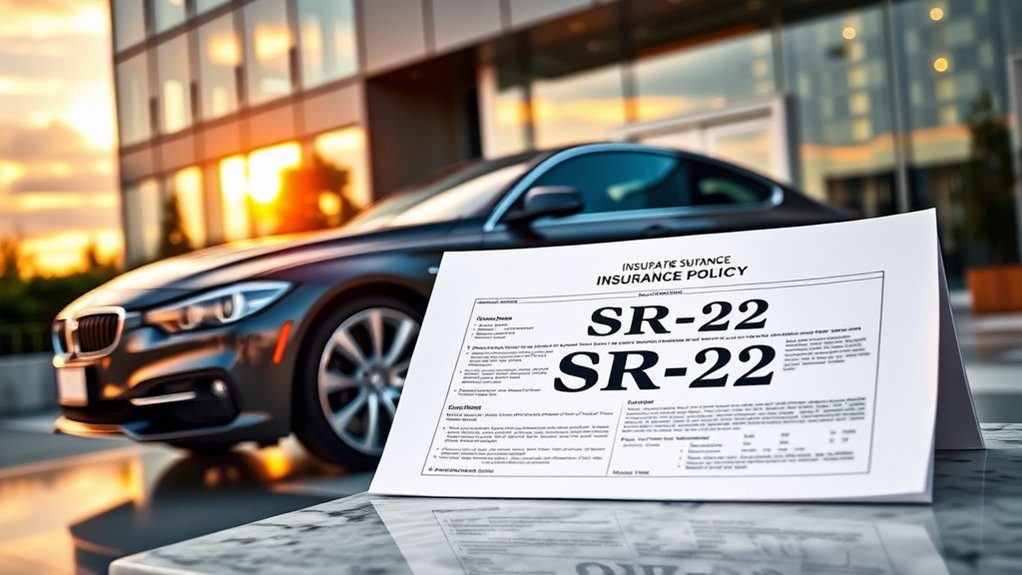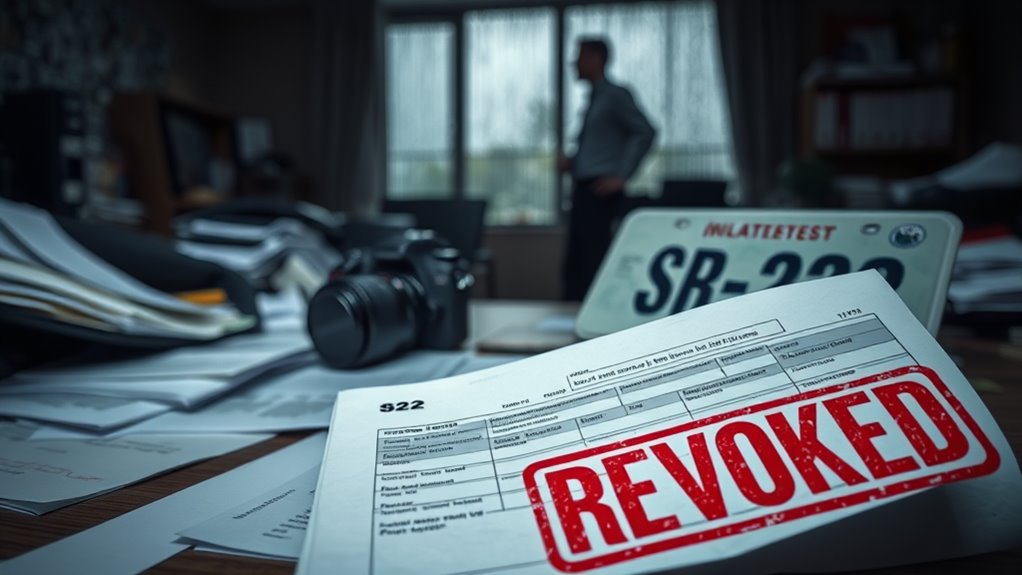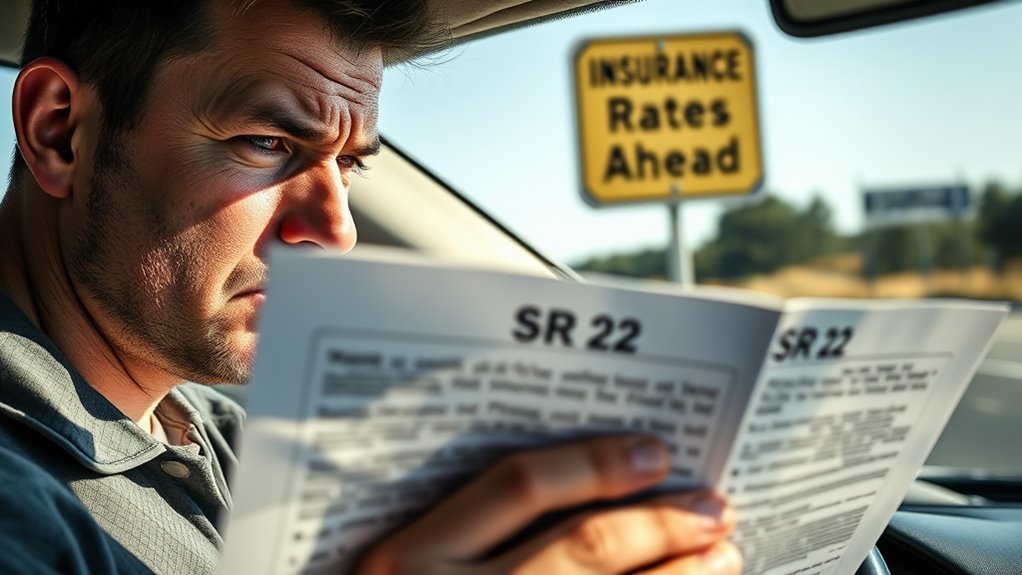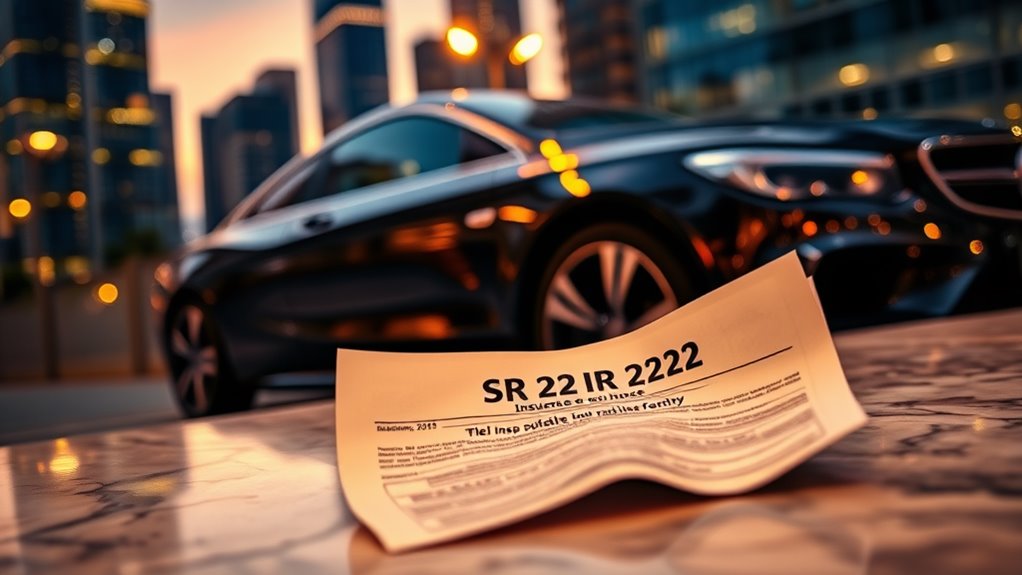Sr-22 Insurance
If you’ve faced serious traffic violations, you might find yourself needing SR-22 insurance. This certificate proves you’ve got the required liability coverage mandated by your state. But what does that really mean for you? Understanding when it’s required, the filing process, and the potential costs involved can make a significant difference in your situation. Let’s explore how SR-22 insurance impacts your driving record and what you need to keep in mind.
Key Takeaways
- SR-22 insurance is a certificate proving financial responsibility required for high-risk drivers after serious traffic violations or insurance lapses.
- Each state has specific SR-22 filing requirements and durations, often ranging from one to 20 years based on the offense.
- Maintaining continuous coverage without lapses is crucial; non-compliance can lead to license suspension and increased insurance premiums.
- Filing fees for SR-22 typically range from $15 to $50, but insurance premiums may rise significantly due to high-risk status.
- It’s essential to verify successful SR-22 filing with your state’s DMV to ensure compliance and avoid legal penalties.
What Is an SR-22?
An SR-22 is an essential document that verifies your compliance with state auto insurance requirements. It’s a certificate of financial responsibility, not an actual insurance policy.

You’ll need this filing if you’re classified as a high-risk driver due to violations like DUIs or multiple infractions. The SR-22 serves as proof of insurance for those with suspended or revoked licenses or those involved in uninsured accidents.
Your insurance provider will file the SR-22 directly with the state on your behalf, and it’s important to maintain coverage, as any lapse will trigger an SR-26 filing, notifying the DMV. This filing is commonly mandated after high-risk driving behaviors such as serious traffic violations.
Requirements vary by state, and some states accept the SR-22 as an alternative to cash deposits.
When Is an SR-22 Required?
You might need an SR-22 if you’ve faced court orders related to traffic violations or if you’ve let your insurance lapse. This requirement guarantees that you maintain minimum liability coverage and comply with state regulations. Understanding these circumstances can help you navigate the process more smoothly. An SR-22 is necessary for license suspension if you fail to meet the requirements after a traffic violation.
Court Orders and Violations
When serious traffic offenses occur, such as DUI or reckless driving, a court may mandate an SR-22 to guarantee compliance with state minimum liability insurance requirements.
This requirement often arises during court hearings for severe violations, where a judge may also impose higher liability coverage than the state minimum.
If you’ve accumulated multiple traffic violations or been involved in at-fault accidents, you could face an SR-22 order as well.
Additionally, driving with a suspended license may trigger the need for one.
Typically, there’s a probationary period before your license is reinstated, during which you must maintain the SR-22 to demonstrate financial responsibility, ensuring you meet state insurance regulations while driving legally.
Insurance Lapse Situations
If a lapse in your insurance coverage occurs, it’s crucial to understand that an SR-22 may be required to demonstrate financial responsibility.
Common reasons for a lapse include missed or late payments, policy non-renewal, switching insurers incorrectly, or failing to renew on time.
The immediate consequences can be severe, such as license suspension and reinstatement fees.
You’ll need to contact your insurer promptly to reactivate your coverage and file a new SR-22 with the DMV.
Remember, gaps in coverage can lead to higher premiums and extended monitoring periods.
To prevent this, consider enrolling in automatic payments, setting early renewal reminders, and regularly reviewing your policy to guarantee compliance with state requirements.
State-Specific SR-22 Rules
How do state-specific SR-22 rules vary across the country? Each state has unique requirements for SR-22 filings.
For instance, Alabama requires an SR-22 for three to five years, while Alaska’s duration can span three to 20 years based on offenses. Connecticut and North Dakota both mandate SR-22 for one year. Texas typically requires it for two years.
States like Florida and Georgia impose SR-22s for serious traffic violations, including DUIs.
In addition to filing requirements, all states necessitate minimum liability insurance coverage, which varies greatly.
If you fail to maintain your SR-22, you may face severe consequences, such as license suspension or increased premiums, so it’s essential to stay compliant with your state’s regulations.
SR-22 Filing Process
When you need to file for an SR-22, it’s essential to understand the specific requirements and timelines involved.
You’ll typically have to provide your insurer with necessary documentation and submit the form promptly to avoid penalties.
Staying on top of these details helps guarantee you’re compliant and can maintain your driving privileges.

Filing Requirements Overview
Understanding the SR-22 filing process is essential for high-risk drivers who need to prove their financial responsibility to the state.
An SR-22 is a form submitted by your auto insurance company to the DMV, confirming you’ve got the required liability insurance. Courts or state authorities often mandate this filing after specific violations, like DUI or driving without insurance.
You must maintain continuous coverage throughout the SR-22 period, which typically lasts three years, although variations exist by state. It’s important to check with your local DMV for specific requirements.
Your insurer may charge a filing fee and adjust your premiums based on your high-risk status, so be prepared for potential increases in costs.
Submission Timeline Details
After you’ve navigated the filing requirements for an SR-22, it’s important to grasp the submission timeline details to guarantee compliance.
The process kicks off when you notify your insurer and either purchase a new policy or update an existing one to include SR-22 coverage.
Keep in mind that filing fees typically range from $15 to $25. After submission, the SR-22 can take over 30 days to process, depending on your state’s DMV.
Some insurers offer immediate electronic filing, while others may require mail submissions. Always verify that the state DMV has processed your filing successfully, as maintaining compliance is essential during the one to three-year SR-22 requirement period.
Cost Implications of an SR-22
The cost implications of an SR-22 can greatly impact your budget. You’ll face a one-time filing fee, typically between $15 and $50, depending on your state.
However, this isn’t the only expense. Your insurance premiums are likely to increase substantially, sometimes by 50% to over 187%, as insurers view you as higher risk due to past violations.
On average, expect to pay about $230 monthly for SR-22 insurance.
Common Misconceptions About SR-22
Many drivers facing SR-22 requirements hold onto misconceptions that can lead to confusion.
First, it’s essential to understand that an SR-22 isn’t a standalone insurance policy; it’s a certificate attached to your existing auto insurance. Some think it automatically provides full coverage, but it only confirms minimum state liability coverage.
Additionally, SR-22 isn’t just for DUI or DWI convictions; it can result from accumulating too many points or lapsing insurance coverage.
You might also believe SR-22 is unnecessary if you don’t own a car, but it’s tied to your driving privileges, not vehicle ownership.
Finally, employers typically won’t know about your SR-22 unless driving is part of your job.

Duration of SR-22 Requirements
The duration of your SR-22 requirements can vary markedly based on your state and the nature of your offense.
Generally, you might expect to maintain this coverage for one to three years, with DUIs often leading to the longer end of that spectrum.
It’s essential to understand your state’s specific rules to guarantee compliance and avoid any gaps in coverage.
Duration Variability by State
While SR-22 requirements can vary considerably by state, understanding the duration of these filings is essential for maintaining your driving privileges.
Here’s an overview of how long you might need to keep your SR-22:
- Three years is the standard in 26 states, including Arizona and California.
- Extended periods can last from three to 20 years, especially for severe offenses or repeat violations in states like Alaska and Arkansas.
- Short-term filings of one year apply in Connecticut and North Dakota, usually for first-time, non-DUI offenses.
Common Compliance Timeframes
Understanding the duration of SR-22 requirements is key to maintaining compliance and avoiding penalties. Most states mandate a compliance period of 1-3 years, with three years being the most common.
In Indiana, you’ll need to maintain coverage for a minimum of 180 days if your suspension is insurance-related. Be certain to keep your policy active without lapses, as any break can restart your compliance period.
The duration can also depend on the offense, like DUI versus uninsured driving. Key dates, such as the incident date or license suspension date, often trigger the compliance clock.
Always check your state agency’s directives for precise requirements to guarantee you stay compliant and avoid further issues.
SR-22 for Out-of-State Drivers
If you’ve recently moved to another state after a license suspension or violation, managing SR-22 requirements can be challenging.
You need to guarantee that your SR-22 aligns with the state where your violation occurred, even if you’re living elsewhere. Here are some key points to take into account:
- Your insurance provider must be licensed in the state requiring the SR-22.
- You might need a non-owner SR-22 if you don’t have a vehicle.
- Timely filings are essential to avoid penalties or extended suspensions.
Keep in mind, failing to maintain the SR-22 in your originating state can risk your driving privileges in your new state.
Contact specialized insurers to help navigate these requirements efficiently.
Differences Between SR-22 and FR-44
Maneuvering the complexities of SR-22 and FR-44 filings can be confusing, especially when dealing with different types of driving violations.
The SR-22 is required for non-alcohol-related offenses like driving without insurance, while the FR-44 is specifically for DUI or DWI convictions. This key distinction affects coverage requirements; SR-22 typically matches state minimum liability, whereas FR-44 often requires double that amount.
The SR-22 covers non-alcohol-related offenses, while the FR-44 is for DUI/DWI and requires higher liability coverage.
Additionally, FR-44 is only mandated in Florida and Virginia, reflecting stricter laws for alcohol-related offenses. Both filings confirm financial responsibility and require continuous coverage for about three years.
If you let your insurance lapse, the consequences are similar: your license could be suspended, affecting your ability to drive legally.

Impact of Non-Compliance With SR-22
Non-compliance with SR-22 can have serious repercussions for drivers, often leading to immediate legal and financial challenges. Ignoring your SR-22 obligations could result in:
- License Suspension: Automatic suspension of your driving privileges by the DMV.
- Increased Insurance Rates: Future premiums skyrocketing due to a lapse in coverage.
- Court Fines and Fees: Additional costs piling up from potential legal penalties.
These consequences not only affect your ability to drive legally but also strain your finances.
You might face hefty reinstatement fees, vehicle registration issues, and even vehicle impoundment.
Ultimately, staying compliant with SR-22 is vital to avoid these complications and safeguard your driving record and financial stability.
Frequently Asked Questions
Can I Drive While My SR-22 Is Being Processed?
You can’t drive while your application is being processed. Until the state confirms your reinstatement, your license remains suspended. It’s essential to wait for official verification before resuming any driving activities.
Will My SR-22 Affect My Credit Score?
Oh sure, your SR-22’s got a secret life affecting your credit score! Spoiler alert: it doesn’t. It’s all about driving violations, not credit. Keep up with payments to avoid indirect hits on your score.
Can I Switch Insurers While Having an SR-22?
Yes, you can switch insurers while having an SR-22. Just make sure your new insurer can file the SR-22 and coordinate the timing to avoid any coverage gaps or lapses in compliance.
What Happens if I Move to Another State With an SR-22?
When you move to another state, you must maintain continuous coverage and notify your new insurance provider. They’ll handle the necessary paperwork to guarantee compliance with your previous state’s requirements and avoid license suspension.
Can I Obtain an SR-22 Without a Car?
Yes, you can obtain an SR-22 without a car. You’ll need a non-owner liability policy, which provides coverage when driving borrowed or rented vehicles, ensuring you comply with state requirements for financial responsibility.
Conclusion
In conclusion, understanding SR-22 insurance is essential for high-risk drivers. While it serves as a lifeline for compliance, failing to maintain coverage can lead to hefty penalties, including higher premiums and license suspension. You’re maneuvering a fine line—your path to regaining driving privileges versus the risk of further legal troubles. Stay informed and proactive, and you can turn a challenging situation into a second chance on the road. Remember, compliance is key to moving forward safely.

